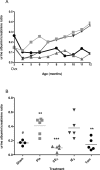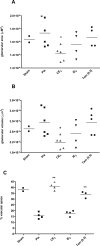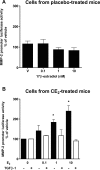Differential effects of continuous and intermittent 17beta-estradiol replacement and tamoxifen therapy on the prevention of glomerulosclerosis: modulation of the mesangial cell phenotype in vivo
- PMID: 16877338
- PMCID: PMC1698782
- DOI: 10.2353/ajpath.2006.051255
Differential effects of continuous and intermittent 17beta-estradiol replacement and tamoxifen therapy on the prevention of glomerulosclerosis: modulation of the mesangial cell phenotype in vivo
Abstract
Female ROP Os/+ mice are partially protected by endogenous estrogens against progressive glomerulosclerosis (GS) during their reproductive period; however, ovariectomy accelerates GS progression. We examined the effects of continuous and intermittent 17beta-estradiol (E(2)) replacement and tamoxifen therapy on the development of GS in ovariectomized (Ovx) ROP Os/+ mice. Continuous E(2) replacement (CE(2)) throughout 9 months prevented microalbuminuria and excess extracellular matrix accumulation in Ovx ROP Os/+, not only compared to placebo-treated Ovx mice but also in comparison to intact female ROP Os/+. Tamoxifen had a similar effect, but of lesser magnitude. Intermittent 3-month on-off-on E(2) did not reduce the kidney changes. Mesangial cells (MCs) from CE(2) mice maintained their estrogen responsiveness. E(2) in vitro prevented transforming growth factor-beta1 stimulation of a Smad-responsive reporter construct and increased MMP-2 expression and activity in MCs isolated from CE(2) mice. MCs from mice on either placebo or intermittent E(2) treatment did not respond to added E(2), consistent with a stable alteration of their estrogen responsiveness. Tamoxifen protection against GS was less pronounced in ROP Os/+ mice. Thus, prolonged estrogen deficiency promotes GS and renders MCs insensitive to subsequent estrogen treatment. This underscores the importance of continuous estrogen exposure for maintaining glomerular function and structure in females susceptible to progressive GS.
Figures








Similar articles
-
Gender-specific effects of endogenous testosterone: female alpha-estrogen receptor-deficient C57Bl/6J mice develop glomerulosclerosis.Kidney Int. 2007 Aug;72(4):464-72. doi: 10.1038/sj.ki.5002328. Epub 2007 May 9. Kidney Int. 2007. PMID: 17495854
-
Estrogen deficiency accelerates progression of glomerulosclerosis in susceptible mice.Am J Pathol. 2003 May;162(5):1441-8. doi: 10.1016/S0002-9440(10)64277-0. Am J Pathol. 2003. PMID: 12707027 Free PMC article.
-
Estrogen-related abnormalities in glomerulosclerosis-prone mice: reduced mesangial cell estrogen receptor expression and prosclerotic response to estrogens.Am J Pathol. 2002 May;160(5):1877-85. doi: 10.1016/S0002-9440(10)61134-0. Am J Pathol. 2002. PMID: 12000739 Free PMC article.
-
Glomerulosclerosis and tubulointerstitial fibrosis are attenuated with 17beta-estradiol in the aging Dahl salt sensitive rat.J Am Soc Nephrol. 2004 Jun;15(6):1546-56. doi: 10.1097/01.asn.0000128219.65330.ea. J Am Soc Nephrol. 2004. PMID: 15153565
-
Inhibition of Advanced Glycation End Products (AGEs) Accumulation by Pyridoxamine Modulates Glomerular and Mesangial Cell Estrogen Receptor α Expression in Aged Female Mice.PLoS One. 2016 Jul 18;11(7):e0159666. doi: 10.1371/journal.pone.0159666. eCollection 2016. PLoS One. 2016. PMID: 27428057 Free PMC article.
Cited by
-
Loss of ovarian function in the VCD mouse-model of menopause leads to insulin resistance and a rapid progression into the metabolic syndrome.Am J Physiol Regul Integr Comp Physiol. 2009 Sep;297(3):R587-92. doi: 10.1152/ajpregu.90762.2008. Epub 2009 May 13. Am J Physiol Regul Integr Comp Physiol. 2009. PMID: 19439618 Free PMC article.
-
17beta-Estradiol attenuates diabetic kidney disease by regulating extracellular matrix and transforming growth factor-beta protein expression and signaling.Am J Physiol Renal Physiol. 2007 Nov;293(5):F1678-90. doi: 10.1152/ajprenal.00079.2007. Epub 2007 Aug 8. Am J Physiol Renal Physiol. 2007. PMID: 17686959 Free PMC article.
-
Subtype specific estrogen receptor action protects against changes in MMP-2 activation in mouse retinal pigmented epithelial cells.Exp Eye Res. 2008 Apr;86(4):653-60. doi: 10.1016/j.exer.2008.01.010. Epub 2008 Jan 17. Exp Eye Res. 2008. PMID: 18313050 Free PMC article.
-
Synaptic plasticity in hippocampal CA1 neurons and learning behavior in acute kidney injury, and estradiol replacement in ovariectomized rats.BMC Neurosci. 2019 Oct 4;20(1):52. doi: 10.1186/s12868-019-0534-4. BMC Neurosci. 2019. PMID: 31585527 Free PMC article.
-
Antifibrotic effect of tamoxifen in a model of progressive renal disease.J Am Soc Nephrol. 2012 Jan;23(1):37-48. doi: 10.1681/ASN.2011010046. Epub 2011 Nov 3. J Am Soc Nephrol. 2012. PMID: 22052053 Free PMC article.
References
-
- Potier M, Elliot SJ, Tack I, Lenz O, Striker GE, Striker LJ, Karl M. Expression and regulation of estrogen receptors in mesangial cells: influence on matrix metalloproteinase-9. J Am Soc Nephrol. 2001;12:241–251. - PubMed
-
- Neugarten J, Medve I, Lei J, Silbiger SR. Estradiol suppresses mesangial cell type I collagen synthesis via activation of the MAP kinase cascade. Am J Physiol. 1999;277:F875–F881. - PubMed
-
- Silbiger S, Lei J, Ziyadeh FN, Neugarten J. Estradiol reverses TGF-beta1-stimulated type IV collagen gene transcription in murine mesangial cells. Am J Physiol. 1998;274:F1113–F1118. - PubMed
-
- Silbiger S, Lei J, Neugarten J. Estradiol suppresses type I collagen synthesis in mesangial cells via activation of activator protein-1. Kidney Int. 1999;55:1268–1276. - PubMed
Publication types
MeSH terms
Substances
Grants and funding
LinkOut - more resources
Full Text Sources
Other Literature Sources
Medical
Miscellaneous

